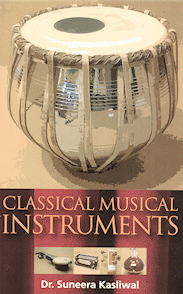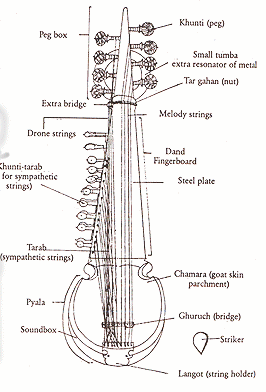Book Review: Suneera Kasliwal's Classical Musical Instruments

Book Review: Suneera Kasliwal's Classical Musical Instruments |

|
By Smita Tanshikar |

India proudly claims an ancient heritage. Treatises in grammar, phonetics, astrology, mathematics, medicine, theology, politics, law etcetera abound to credit this belief. By the time Bharat discussed it, music already attained an exalted stature growing continuously from its Vedic roots. The three notes – Uddatt, Anuddatt and Swarit – in Sam Veda numbered full seven by the time of Bharat. Several instruments, chiefly Veena-s, too had gained new attributes by this time. Natyashastra of Bharat evinces the research done ever since Vedic age, in the area of musical instruments – wind, percussion and strings.Since Bharat, there has been huge change in some, while certain other instruments retained their ancient form. A 1971 volume published in Hindi by Jnanpith traced the development of these instruments from Vedic period right down to twentieth century. A few take-off versions too were published in Hindi. Western scholars who learned Indian music occasionally published their study, but no book which explains Indian instruments was available in English apart from B. C. Deva’s Musical Instruments of India.
Suneera Kasliwal’s Classical Musical Instruments was first published in 2001. Rupa assessed this to be a popular book and published it in 2004. It was a successful venture as vouched by its reprint in 2006. The author has since moved further into realm of presenting research for popular consumption with one on Ravanhattha, as her earlier one finds place in syllabus of some institutions. The present discussion arises from both – the slow pace of acceptance and dearth of a true academic presentation. But first, a quick summary of Rupa paperback.
The book has been divided into five chapters – percussion, wind, string, western and electronic instruments. It is uplifting to find western instruments in a volume on Classical music (presumably, Indian). There are sufficient diagrams, sketches to break the monotony of print. That Dr. Kasliwal has been with her subject is borne out by a comprehensive bibliography. The book also has an exhaustive index and with a shiny left of Tabla on the cover, is well-produced. The final chapter is the highlight as it discusses, almost for the first time, the range electronic music instruments. A singular vision and a couple’s dedication to their dreams has made it possible to learn and practice Indian music in remote locations. In the final twenty pages Dr. Kasliwal introduces inventor from Bangalore, G. Rajanarayan and his inventions, SurPeti, Tala Aid for Carnatic music, Tanpura in various versions, Tabla and Lehra player. She also explains how H.V. Modak’s Automatic Musical Instrument works and how it can be used to judge accuracy of a singer, but ends the book wondering why it failed to attain popularity of Bangalore instruments.
The history of instruments, by and large, has been traced with clarity. For example, the evolution of Mridang (explained as Mrit (earth or mud) and Ang (part/ organ)) from bulging drums in Bharhut (c 150 BC) and Sanchi (c 150 BC) along with mythological references is interesting. The difference between its modern north Indian (Pakhavaj) and south Indian (Mridangam) has also been explained in simple words. The author relies on Curt Sach’s presumptions about origin and development of Indian musical instrumrnts. Mention is made of Tripushkar, but while giving a hint of Tabla evolving from this, avoiding controversy, Tabla is accepted as a evolution of ‘martial drums, which accompanied the military expeditions of Muslims’. Other percussion instruments that find place in the book are Dukkad, Khol, Ghatam, Khanjeera and Morchhang.
In the section on string instruments, the history of Veena-s is once again traced correctly without going into details. The author points out that descendents of Tansen called Rudra Veena, Saraswati Veena (out of reverence to the Goddess) but fails to address nomenclature of Tanjauri Veena as Saraswati Veena. Dr. Kasliwal, however rises to occasion by disproving origin of Sitar from Persian Sehtar by citing Dr. Misra’s explanation of its development from Tritantri Veena which was later referred to as Yantra or Jantra.
In the section on Western instruments, Harmonium has been discussed in detail; hinting at its controversial compatibility with Indian notes, yet with a non-committal stance. Kadri Gopalnath has been hailed for Herculean efforts to get Saxophone accepted for playing Carnatic music. Darshan Singh is also remembered for playing Hindustani classical music in 1950s. Though in brief, historical acceptance of Violin in both streams of Indian music has been outlined. Commentary about its technique with reference to Indian music would have satisfied most readers as this is one of the most familiar instruments. Similarly, origin of Guitar finds more space than its application to Indian music.
As a popular book, it does not tire the reader either with details or jargon, choosing to quote simple passages where necessary. Dr. Kasliwal accepts Dr. Lalmani Misra’s thesis that struck instruments – Tarang Vadya – should be classified separately but does not get a chance to do so in this volume. Forced by the form, she was liberal with content and thus allowed inclusion of occasional folk instruments that have found their way in as accompaniment to main instrument. The hallmark of this book is the clearly labeled diagrams which satisfy the curiosity of an average reader.
Dr. Kasliwal in association with Sageet Natak Akademi and other institutions of repute worked towards identification, categorization, preservation and promotion of musical instruments. She has also organized exhibitions to instill awareness about Indian musical heritage, apart from holding workshop on manufacturing process. She has been instrumental in launch of heritage preservation initiative where master craftsmen are training novitiates the art of making Veena-s. Almost a decade since first publication of this book, despite ceaseless involvement, the lack of a serious work from scholar of such lineage and proven merit has kept academia waiting with crossed fingers. Dr. Kasliwal owes it to herself to present a thesis befitting her stature and work. The least she can do is to revise it to remove the creases and boldly identify musical instruments accepted out of fashion from the truly classical ones. It would thereby inform the lay reader and who knows, might save Indian Classical Music from being derailed with half-baked experimentation and fast-buck-fusion liaison that vie with each other to hog the lime-light.
Order or browse collection on Omenadshop.
Suggested:
Bharatiya Sangeet Vadya on wikipedia
Sitar Compositions in Ome Swarlipi Read Review by Pt. Omprakash Chaurasiya
Bhāratīya Shāstrīya Sangīt: Shāstra, Shikshan Va Prayōg
List of books on music.
Musical tracks.
Annotated compositions.